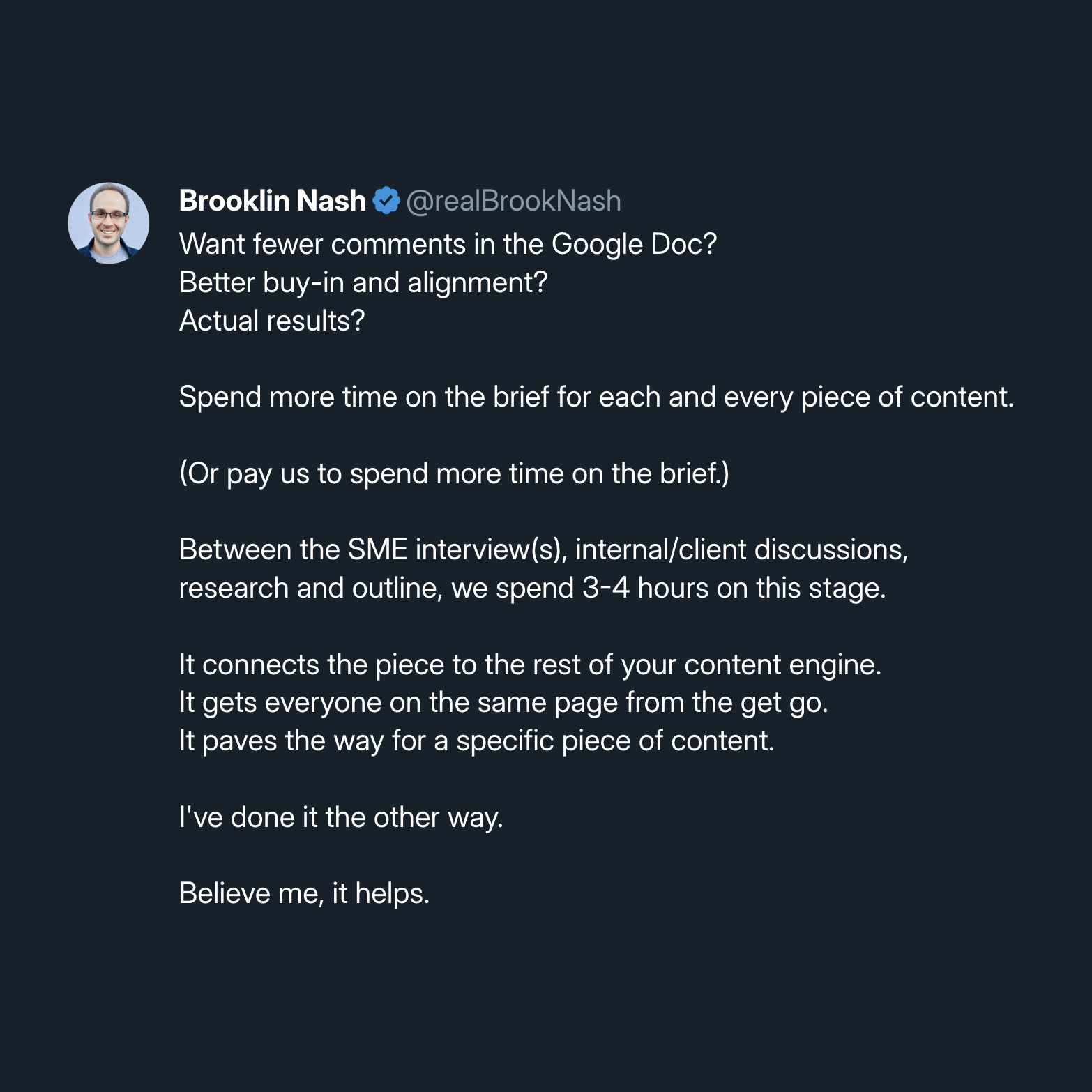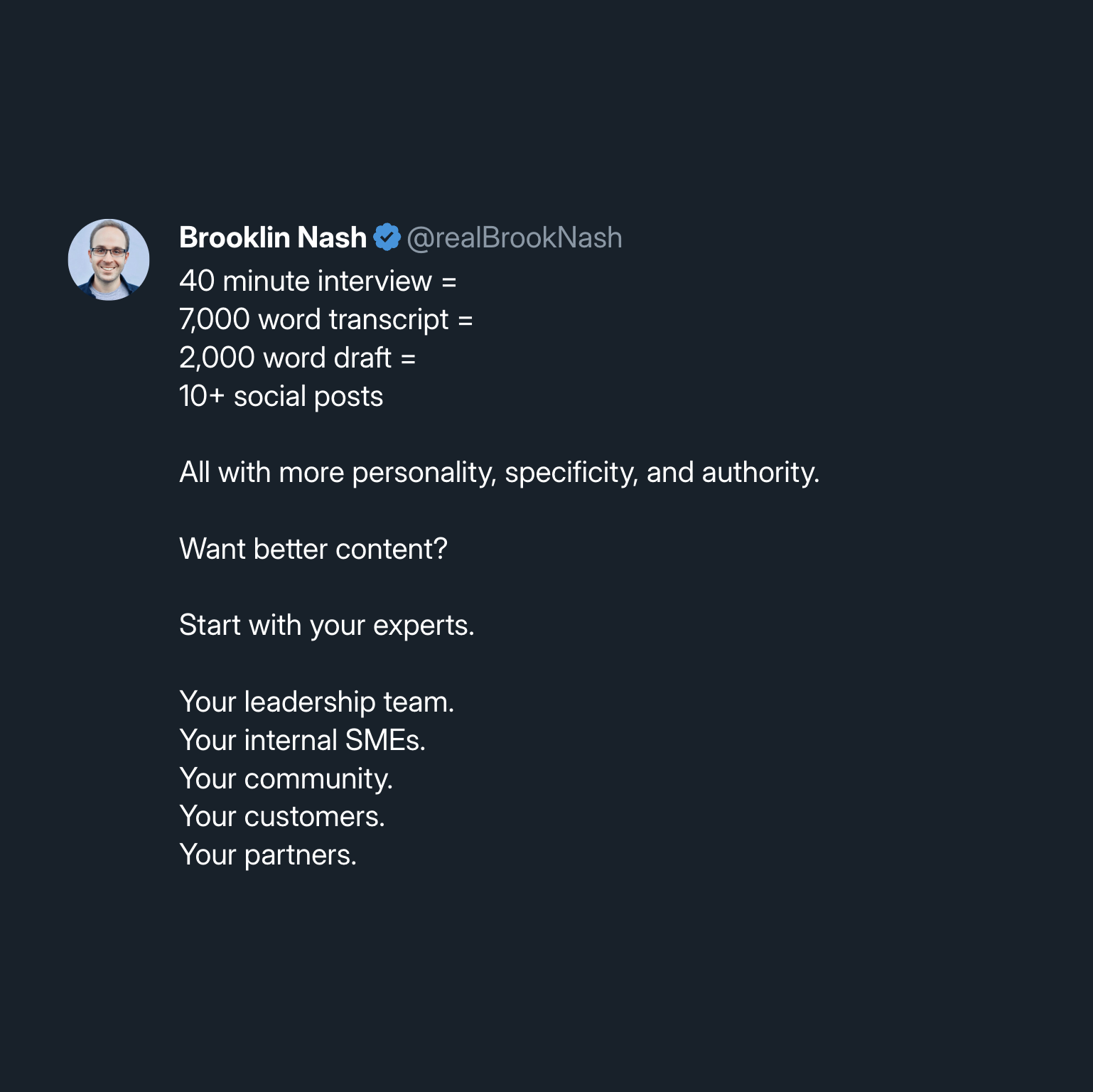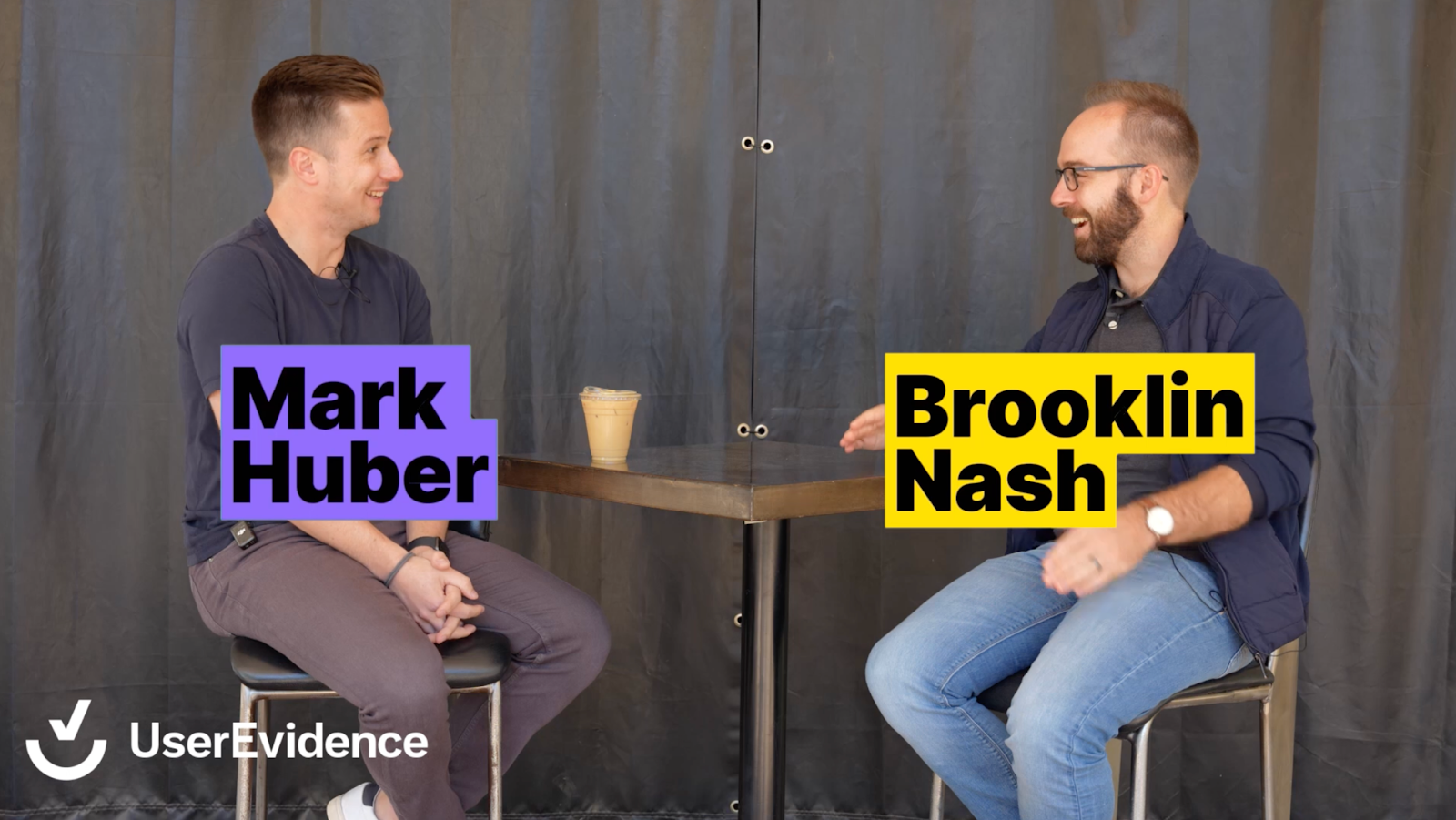What comes before the writing | 3 Stages that anchor your content workflow


Poor strategy alignment cascades into weak briefing. Weak briefing leads to bland research and interviews (if any), which then results in content that’s harder to write, trickier to edit, and therefore unlikely to meet expectations.
Strategy, briefing, and interviewing—this behind-the-scenes prepwork creates original, resonating content only when these stages reinforce each other. Before a single word is written. Producing content that connects, powered by subject matter experts (SMEs), takes more than dumping unstructured thoughts into a doc and calling it a day.
After having a conversation with Beam’s co-founder Brooklin Nash on what comes before the writing, I’ll do my best to break down how the sometimes overlooked prepwork that goes into a content engine impacts the creation of content. This way you can self-audit your org’s system, and optimize it as you see fit. Or leave it to Beam.
Why fragmented, hit-or-miss content production is problematic
The moment content gets purposeless, rushed, and commoditized, things start falling apart. Inconsistent brand themes, sporadic publishing rhythm, and all of a sudden, checkbox marketing siloed from a strategy. Why?
Lack of cohesion between teams and content
If you’re jumping straight to execution, skipping the groundwork, you might get something decent on the surface. Your content team may be creating well-produced marketing assets and have a nonexistent strategic direction.
Both things can be true. Someone identifies an industry trend, someone else pitches a product-led piece, and another someone suggests a creative idea for social. But, without an overarching narrative, these disconnected random acts of marketing just check boxes, waste brand momentum, and make the org’s content end up in silos.
The thing is, a glorified to-do list with timeframes, channels, and formats rarely stands the test of time. It’s an approach that perpetuates the hamster wheel where content looks busy, looks productive but accomplishes little.
Inconsistent messaging and cadence
“All of this isn’t just about focusing you on the right message. It’s also setting you up for the right production process so that over the course of a quarter or two, you have consistency in what you publish.” Brook notes.
It’s not either-or, it’s two sides of the same coin. Inconsistent themes (unspecific content which isn’t tied to evidence, value props, or products), and an inconsistent publishing cadence. Both reflect silos in the GTM org.
Want to expand on the nitty-gritty of what constitutes high-quality content for Beam? Sabina Hahn, Head of Client Success + Strategy at Beam, wrote a piece for you: You don’t need more content, you need content that does more.
Disconnection from the larger strategy
Ideally, there should be crystal clear clarity on what matters in the GTM plan before anyone starts crafting content.
Brook has experienced this disconnection a couple of times through the lenses of Beam’s customers, “We were just onboarding a new client. Marketing was all in on this AI-powered marketing message. Then we jumped on with the sales leaders, and they shared the exact opposite: ‘It’s hard to sell on AI so we’re selling on this, this, and this.’”
For clarification, those 3x [this] translate into different value props the marketing team wasn’t initially considering.
Some content folks allocate resources into thought leadership, cool visuals, and technical material only to realize down the road that other GTM teams need poles apart messaging to address prospect objections. And by the time this misalignment happens, budgets have evaporated on content that doesn’t support actual sales or CS initiatives.
Prewriting stages that go into Beam’s content system
To create original, differentiated content, Beam’s production workflow assigns around 15 content tasks to 5 specialized roles from start to finish. Most of that operation is shaped during the prepwork stages that follow.
1. Strategy alignment → The compass for content
“Everything that comes before you open up that draft, or before you assign it to a writer, is the most critical piece. Unless you’re a CTO opening up a blank page who can speak authoritatively to other CTOs based on your lived experiences, you have to put in an upfront work so what you produce is grounded in expertise.” Brook says.
Who’s the ideal customer profile (ICP) and audience? What pain points do we solve? Where’s the narrative? How does a topic ground into the wider GTM content strategy? Is there any cross-departmental functionality at all?
Rushing strategy ignores foundational questions. And the emptier the answers, the more generic the output.
Brook adds “Content’s only going to be as impactful as long as it’s connected to what your audience is interested in, engaged, and needs answered.” We started Beam to be like... ‘You have these things going—email, SEO, social—and you’re producing this and that. What if we could take a step back and create something more impactful?’”
Here’s exactly where you ground your content production in validated themes drawn from your sources of truth. Like ICP challenges and jobs-to-be-done (JTBD), intel from product marketing on positioning and differentiation, and direct input from sales and customer success (CS) teams who interact with prospects and clients all day long.
This validation earns content marketers a seat at the revenue table. Less “We have these 8 topics, here’s a few bullets on each. Go write it.” And more “This is our plan for content over Q3 and Q4. Hey other functions, here’s what’s coming up. Here’s what we’re grounding the content in. And here’s the plan for executing on it.”
Without prioritizing strategic alignment, content assets go to waste and the customer experience fractures.
Deficient cross-departmental communication makes it even harder for sales, marketing, customer support, and product teams to align and get the most out of content—collectively. Nick Bennett, former co-founder of TACK, refers to that gap between silos as an opportunity for creating “educational, inspirational, actionable, and helpful” content that actually serves multiple departments. Beam expanded on this in the Closing the Content Gap report.
2. Briefing → Putting it all together
Former Head of Content at Beam, Anthony Marovelli, defined a brief as a document that encapsulates the set-up + audience, the client’s needs, and the writer’s toolbox. Think of it as the hub to get everyone on the same page.
You can save interviews there, check guidelines, consult research, revisit the outline framing, and have a “cheat sheet” to remind collaborators “Ok, this is what we’re working with.” Which ends up being valuable for who’s in charge of the writing side of things, the Editor, the Head of Content, the Head of Client Success, and the Content Strategist.
Contrary to popular belief, expert-driven briefing does help get better buy-in and alignment with stakeholders, too. Meaning, threading the needle between what GTM functions run into and what the org leadership wants to achieve.
From my chat with Brook, he exemplifies “You can tell when there’s nothing with a through line from what demand gen’s putting out in ebooks and gated content, and what the CTO is posting on social.” So instead of developing whatever idea that comes along, he suggests anchoring GTM content to 3-5 pillars over the course of a year, “bringing it all the way back to your product marketing, real pain points, and what your audience cares about.”
Remember, this prior coordination through the briefing process would catch disconnects like the AI messaging problem early, before any department invests months assembling materials others within the org can’t really use.

Briefing, the stage we’re discussing now, makes room for connecting the dots across otherwise isolated pieces of information: SME insights, the outline, data from original research, external/internal resources (and so on—see brief template). Beam approaches prewriting stages iteratively. Stages loop, intersect, and reinforce each other.

When it comes to briefing, besides collecting information, critical thinking and creativity play an important role in synthesizing disparate stakeholder needs into a coherent document that aligns with the org context, guidelines, and the GTM bigger picture. You’re pulling together a unifying framework to strategically address overlapping priorities.
It doesn’t have to be perfect but should present an opportunity to get everyone—from the Content Marketing Manager to the Head of PMM to the CEO—rowing in the same direction, before you write a word of the draft. This groundwork then shapes which experts you need to have conversations with, and what set of questions to ask them.
3. Interviewing → Original POVs
Talking to experts (or, interviewing SMEs) needs a good amount of prepwork. Even if not all content marketing teams perceive the effort of coordinating interviews as viable, GTM functions do. For the most part because it borrows cross-departmental intel, customer insights, and industry insiders’ perspectives outside the organization.
Depending on what type of content depth you’re planning to produce, conversations with experts may pave the way differently. Based on the strategy alignment and briefing prewriting stages from earlier, Beam narrows down 3 levels of content depth (visionary, strategic, and tactical) so the team can start a smarter expert hunting for each piece.
At that point, content transcends from stuff anyone could have searched online or asked to a generative AI tool to an original, authentic, credible POV that basically lives in an expert’s brain and its day-to-day job responsibilities.
For what it’s worth, this isn’t to say AI isn’t helpful. “We’re trying to lean on AI to surface and summarize insights from disparate data sources in a way that allows for human-powered strategy and content.” Brook says, “We use an AI research tool called Marvin where we put every SME interview we run in there. And it creates a library based on the documentation we have, and the conversations we’re having, instead of an LLM’s all public knowledge.”
You can’t (at least not yet) artificially manufacture human genuineness. The depth of an angle that comes from an organic discussion with an SME where there’s nuance, unexpected tangents, and layers of emotional emphasis.

If you’d rather hire the Beam team to have conversations with SMEs for your org—and the rest of all things GTM content campaign—you could. Mark Huber, VP of Marketing at UserEvidence, has been doing it like that since 2021.

“One of the things I’ve been trying to do more lately at UserEvidence is getting content ideas from sales in the first place. Not in a way that every idea submitted = a guaranteed piece of content, but trying to see what sales think they need. And if it comes up a couple of times from different people then the lightbulb goes on for me like ‘We should get this to Beam.’” Mark said during UserEvidence’s Spryng 2024 series: “Finding GOLD in Expert Interviews.”
Once you’ve packed your calendar with SME interviews and gathered enough insights, you have to integrate findings throughout your brief. For example, niche-specific data or unique customer stories that answered an unscripted follow-up question will refine/reframe your brief, and therefore, nurture the work-in-progress draft.

Notice on the screenshot above how Brook mapped the article’s key questions, points to address, and pulled messaging from that project guide. That’s what a narrative frame looks like after interviewing an SME. And again, these expert insights then loop back to refine your brief, creating a feedback cycle that strengthens other stages.
Start with your biggest content disconnect
Hopefully, you now get what anchors content production: strategy alignment, briefing, and conversations with experts. Understanding, though, isn’t implementation. Want to diagnose where your own prepwork falls short?
Look for the disconnects. Is it marketing creating content sales won’t use? Leadership posting on social messages that contradict active campaigns? Writers starting from scratch because no one documented brand guidelines?
Find that gap. Then trace it backward. If demand gen can’t use your content, you likely skipped strategic alignment. If writers lack direction, your briefing process needs work. If content sounds generic, you’re missing expert voices.
Sure, not every team out there is ready for SME interviews or cross-functional briefing. Do what you realistically can. Even one 15-minute exchange with a GTM department that’s different from yours beats writing in a vacuum.
The content stages scale with your resources. But the core principle remains the same—what comes before the writing often determines what happens after the writing. When you’re ready to delegate things, Beam can help.
%202.svg)

%203.svg)